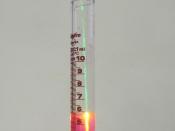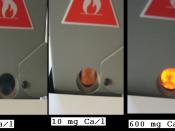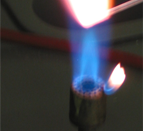1.0 INTRODUCTION
Flame photometry, also referred to as 'flame atomic emission spectrometry' is a quick, economical and simple way of detecting traces of metal ions, primarily Sodium, Potassium, Lithium, Calcium, and Barium, in a concentrated solution. The process is an extension of the principles used in a flame test, with the main differences having more precision in the results, and the use of more advanced technology. This report focuses on the theory, applications, limitations and analysis of Flame Photometry.
2.0 EXPLANATION OF THEORY
2.1 A flame photometer is an instrument used for measuring the spectral intensity of lines produced by metals present in ionic compounds. "Measuring the flame emission of solutions containing the metal salts is done to perform a quantitative analysis of these substances" (Internet 1).
2.2 The electrons of an atom exist in different energy levels. When energy is added to an atom in the form of light/heat/electrical energy, the atom becomes excited and electrons begin to 'jump' to higher energies (Figure 1).
There are two states that an atom can exist - an excited state and a ground (natural) state. The ground state of an atom is when the electrons are in their lowest energy level. The use of a flame photometer "relies on the principle that a metal salt drawn into a non-luminous flame will ionise, absorb energy from the flame and then emit light of a characteristic wavelength as the excited atoms decay to the unexcited ground state" (Internet 10).
Fig.1
2.3 Flame photometers work by vaporizing metallic salts in a very hot flame: when a solution of a salt, such as sodium is sprayed into the flame, the elements in the compound are partially converted into their atomic state. "Due to the heat energy of the flame a very small proportion of these atoms...


